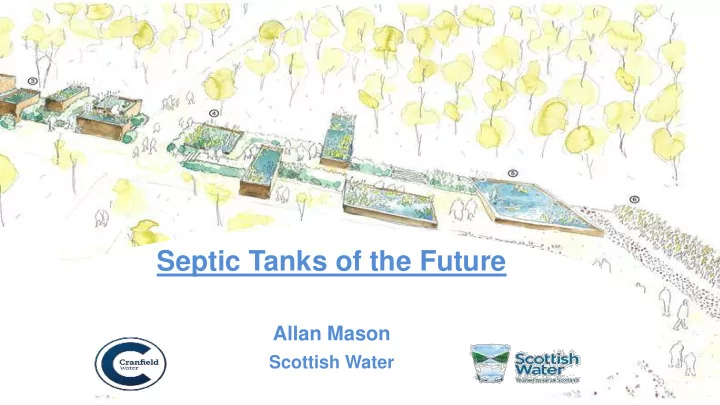

Septic Tanks of the Future Allan Mason Scottish Water
Sustainable Rural Communities - Household Water Usage B uilding and providing the assets, infrastructure and service that enable us to meet our needs now without jeopardising our ability to meet future needs. I t is about building the consistent, upgradable assets that do not damage the environment and do not break the bank to implement.
Background • Scottish Water has over 1000 Septic Tanks for primary treatment in rural locations. • The Future • Low sludge production or treatment locally • Energy generation • Able to incorporate food waste to increase energy generation • Able to manage surface water flows to provide local flood attenuation • Water Reuse
Challenges
Household Water Usage
Issues in Scotland
Septic Tank of the Future A Scottish Water & Cranfield University Collaboration Prof Bruce Jefferson Dr Gabriela Dotro Mr Gareth Brown
Septic Tanks of the Future flowsheet The aim of this project was to provide an outline design and cost estimates for the novel sewage treatment flowsheet
Descriptive consents Septic Tank vs Anaerobic Pond Descriptive consents
Numeric consents Anaerobic Pond + Wetland vs SAF plant
Adding value
Highlights Based on example 100 pe works • Sites with descriptive consents can be upgraded to an anaerobic pond to improve effluent quality, improving the desludging interval and future proof. • Breakeven point is 3 to 7 years. • Transport carbon emissions savings of >80% • Relaxed consents and medium consents can be met with either AP+ VF wetland or AP + aerated HF wetland • Both wetland flowsheets have similar WLC and are c. 70% lower CAPEX, OPEX and WLC compared against the SAF • VF systems offer off-grid operation potential ( lower WLC) • Operational carbon emissions savings of 88% and 98% for AHF and VF • Adding the tertiary SF system provides additional benefits without impacting WLC
Results air Surface wetland Aerobic wetland Anaerobic Pond
Benchmarking against standard options Relaxed and medium consents £300K £250K £200K Cost £150K £100K £50K 0 CAPEX OPEX WLC AP + AHF AP + VF PT+SAF+HT
Benchmarking against standard options Descriptive consents £60K £50K Whole life cost £40K £30K £20K £10K 0 0 2 4 6 8 10 12 14 16 Desludging interval (years) Anaerobic Pond Septic Tank (6-month) Septic Tank (12-month)
Impact on carbon emissions - Transport
Operational carbon emissions
Key uncertainties to resolve • Anaerobic ponds: • Impact of baffles on solids removal efficiency • S olids accumulation rates at low temperature wastewater • Treatment performance under flow variations • Biogas production rates and quality • Impact of biowaste addition on methane production and performance • Engaging with potential suppliers on design needed (GRP & soil) • Wetlands: • Performance with AP effluent • Impact of depth on AHF performance • Hydraulic limits with locally sourced materials • Configurations to achieve TN removal* • Passive alkalinity amendments*
Doctorial Research - Aim The overall aim of the project is to deliver a robust design approach for the novel flowsheet by resolving areas of uncertainty and risk. 1. Establishing the specific hydrolysis rate under low temperatures and assessing options to enhance it. 2. Establishment of the size and settling rate of particles within the pond and trial methods to increase the removal rate. 3. Establishment the benefit and impact of adding bio-waste to the pond. 4. Trial and determine the most appropriate configuration of wetland to meet different discharge consents. 5. Revise and adapt the initially proposed design standard
Inclusion of Bio-wastes • Impact • How to include • Benefits and dis-benefits
Integration in urban designs Image from Molle (2017) at 6 th Low Energy Wastewater Treatment Systems Conference, Cranfield University.
Community perspectives on sustainable wastewater services for rural areas
Gracey’s Journey
Overall aim and individual objectives
The European test facility network for water innovation Goal: Speed up market uptake of innovative water technology Tool: Fully-funded tailored support to access the transnational network of 14 operational testing facilities SMEs can develop, test and verify innovative technology in a real environment The funding call is now open! WaterTestNetwork@scottishwater.co.uk www.nweurope.eu/water-test-network/
Recommend
More recommend